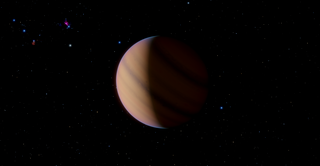Related Research Articles

Aldebaran is a star located in the zodiac constellation of Taurus. It has the Bayer designation α Tauri, which is Latinized to Alpha Tauri and abbreviated Alpha Tau or α Tau. Aldebaran varies in brightness from an apparent visual magnitude 0.75 down to 0.95, making it the brightest star in the constellation, as well as (typically) the fourteenth-brightest star in the night sky. It is positioned at a distance of approximately 65 light-years from the Sun. The star lies along the line of sight to the nearby Hyades cluster.

Pollux is the brightest star in the constellation of Gemini. It has the Bayer designation β Geminorum, which is Latinised to Beta Geminorum and abbreviated Beta Gem or β Gem. This is an orange-hued, evolved red giant located at a distance of 34 light-years, making it the closest red giant to the Sun. Since 1943, the spectrum of this star has served as one of the stable anchor points by which other stars are classified. In 2006 an exoplanet was announced to be orbiting it.
HD 150706 is a star with an orbiting exoplanet in the northern constellation of Ursa Minor. It is located 92 light years away from the Sun, based on parallax measurements. At that distance, it is not visible to the unaided eye. However, with an apparent visual magnitude of 7.02, it is an easy target for binoculars. It is located only about 10° from the northern celestial pole so it is always visible in the northern hemisphere except for near the equator. Likewise, it is never visible in most of the southern hemisphere. The star is drifting closer to the Sun with a radial velocity of −17.2 km/s.
HD 130322 is a star with a close orbiting exoplanet in the constellation of Virgo. The distance to this system is 104 light years, as determined using parallax measurements. It is drifting closer to the Sun with a radial velocity of −12.4 km/s. With an apparent visual magnitude of 8.04, it is too dim to be visible to the naked eye; requiring binoculars or a small telescope to view. Being almost exactly on the celestial equator the star is visible everywhere in the world except for the North Pole. The star shows a high proper motion, traversing the celestial sphere at an angular rate of 0.197 arcsec yr−1.
HD 1237 is a binary star system approximately 57 light-years away in the constellation of Hydrus.

Pollux b, formally named Thestias, is an exoplanet candidate orbiting the star Pollux approximately 34 light-years away in the constellation of Gemini. It is also designated β Geminorum b or HD 62509 b. If this planet exists, it has a minimum mass of about twice the mass of Jupiter, and it moves around Pollux in 1.61 years at a distance of 1.64 AU in a nearly circular orbit. However, its existence has been disputed.
HD 154345 is a star in the northern constellation of Hercules. With an apparent visual magnitude of +6.76 it is a challenge to view with the naked eye, but using binoculars it is an easy target. The distance to this star is 59.6 light years based on parallax, but it is drifting closer with a radial velocity of −47 km/s. At least one exoplanet is orbiting this star.

HD 47536 is a single star in the southern constellation of Canis Major. It has an orange hue and is dimly visible to the naked eye with an apparent visual magnitude of +5.25. The star is located at a distance of approximately 408 light years from the Sun based on parallax. It is drifting further away with a radial velocity of 80 km/s.
HD 43691 is a star with an orbiting exoplanet in the constellation Auriga. With an apparent visual magnitude of 8.03, it is too faint to be visible to the naked eye. This system is located at a distance of 279 light years based on parallax measurements, but is drifting closer with a heliocentric radial velocity of −29 km/s.
NGC 2423-3 is a red giant star approximately 3,040 light-years away in the constellation of Puppis. The star is part of the NGC 2423 open cluster. The star has an apparent magnitude of 10 and an absolute magnitude of zero, with a mass of 2.4 times the Sun. In 2007, it was proposed that an exoplanet orbits the star, but this is now doubtful.

HD 13189 is a star with an orbiting companion in the northern constellation of Triangulum constellation. With an apparent visual magnitude of +7.57, it is too faint to be visible to the normal human eye. The distance to this system is approximately 1,590 light years based on parallax measurements, and it is drifting further away with a radial velocity of 25.39 km/s. In 2005, a planetary companion or brown dwarf was announced in orbit around this star.
81 Ceti is a star located approximately 331 light years away from the Sun in the equatorial constellation of Cetus. 81 Ceti is the Flamsteed designation for this object. It is visible to the naked eye as a dim, yellow-hued point of light with an apparent visual magnitude of 5.65. The star is drifting further away from the Earth with a heliocentric radial velocity of +9 km/s.

CoRoT-7b is an exoplanet orbiting the star CoRoT-7 in the constellation of Monoceros, 489 light-years from Earth. It was first detected photometrically by the French-led CoRoT mission and reported in February 2009. Until the announcement of Kepler-10b in January 2011, it was the smallest exoplanet to have its diameter measured, at 1.58 times that of the Earth and the first potential extrasolar terrestrial planet to be found. The exoplanet has a very short orbital period, revolving around its host star in about 20 hours.
CoRoT-7 is a binary star system made up of a late G-type star and a M-dwarf star that was discovered in 2021. The primary star has three exoplanets, including CoRoT-7b, a super-Earth exoplanet that is remarkable due to its extremely high temperature and very short orbital period, around 20 hours. It was the first exoplanet shown to be rocky. The system has the name CoRoT-7 after the CoRoT space telescope, which discovered the exoplanets around the star CoRoT-7A. The stellar system is 520 light-years from the Earth.
Gamma1 Leonis b is an extrasolar planet located 125.5 light years away in the constellation Leo, orbiting the giant star Gamma1 Leonis.
HD 25171 is a star with an orbiting exoplanet in the southern constellation of Reticulum, the reticle. With an apparent visual magnitude of 7.79, this star is too faint to be viewed with the naked eye. However, it is readily visible through a small telescope from the southern hemisphere. Parallax measurements place it at a distance of roughly 182 light-years from Earth. It is drifting further away with a heliocentric radial velocity of +43 km/s.

HD 114613 is a fifth magnitude yellow subgiant star that lies 66.7 light-years away in the constellation of Centaurus.
HD 120084 is a star with an orbiting exoplanet in the northern constellation of Ursa Minor. With an apparent magnitude of 5.91, it is just visible to the naked eye in suburban skies. The distance to this system is 339 light years based on parallax measurements, but it is drifting closer to the Sun with a radial velocity of −9 km/s.

Kepler-21, also known as HD 179070, is a star with a closely orbiting exoplanet in the northern constellation of Lyra. At an apparent visual magnitude of 8.25 this was the brightest star observed by the Kepler spacecraft to host a validated planet until the discovery of an exoplanet orbiting HD 212657 in 2018. This system is located at a distance of 354 light-years from the Sun based on parallax measurements, but is drifting closer with a radial velocity of −18.2 km/s.
HD 121056, or HIP 67851, is an aging giant star with a pair of orbiting exoplanets located in the southern constellation of Centaurus. This star is dimly visible to the naked eye with an apparent visual magnitude of 6.17. It is located at a distance of 209 light years from the Sun, based on parallax measurements, and is drifting further away with a radial velocity of 5.6 km/s.
References
- 1 2 3 Farr, W. (2018). "Aldebaran b's temperate past uncovered in planet search data". The Astrophysical Journal. 865 (2): L20. arXiv: 1802.09812 . Bibcode:2018ApJ...865L..20F. doi: 10.3847/2041-8213/aadfde . S2CID 56049041.
- ↑ Hatzes, A.P.; et al. (May 15, 2015). "Long-lived, long-period radial velocity variations in Aldebaran: A planetary companion and stellar activity". Astronomy & Astrophysics. 580: 18. arXiv: 1505.03454 . Bibcode:2015yCat..35800031H. doi:10.1051/0004-6361/201425519. S2CID 53324086.
- 1 2 Reichert, Katja (March 25, 2019). "Precise radial velocities of giant stars XII. Evidence against the proposed planet Aldebaran b". Astronomy & Astrophysics. A22: 625. arXiv: 1903.09157 . Bibcode:2019A&A...625A..22R. doi:10.1051/0004-6361/201834028. S2CID 85459692.
- ↑ Gray, R. O.; Corbally, C. J.; Garrison, R. F.; McFadden, M. T.; Bubar, E. J.; McGahee, C. E.; O'Donoghue, A. A.; Knox, E. R. (2006). "Contributions to the Nearby Stars (NStars) Project: Spectroscopy of Stars Earlier than M0 within 40 pc-The Southern Sample". The Astronomical Journal. 132 (1): 161–170. arXiv: astro-ph/0603770 . Bibcode:2006AJ....132..161G. doi:10.1086/504637. S2CID 119476992.
- ↑ Fraser Cain (September 15, 2008). "Temperature of the Sun". Universe Today . Retrieved February 19, 2011.
- ↑ Hatzes, A.; Cochran, W. (1993). "Long-period radial velocity variations in three K giants". The Astrophysical Journal . 413 (1): 339–348. Bibcode:1993ApJ...413..339H. doi: 10.1086/173002 .
- ↑ Hatzes, A. P.; Cochran, W. D.; et al. (2015). "Long-lived, long-period radial velocity variations in Aldebaran: A planetary companion and stellar activity". Astronomy & Astrophysics. 580: A31. arXiv: 1505.03454 . Bibcode:2015A&A...580A..31H. doi:10.1051/0004-6361/201425519. S2CID 53324086.



